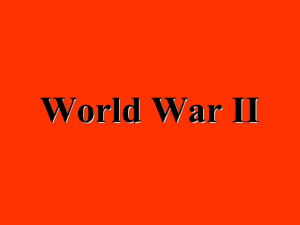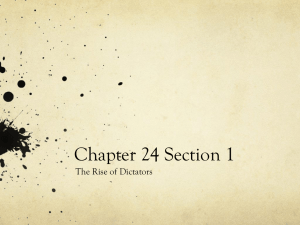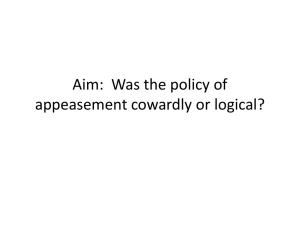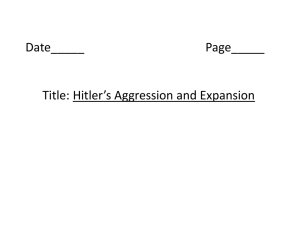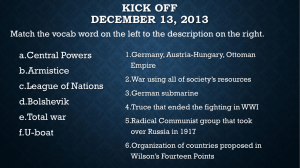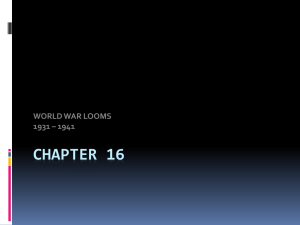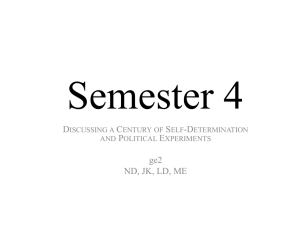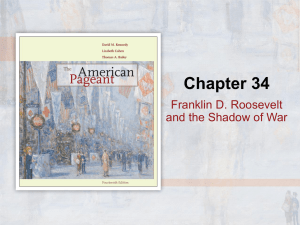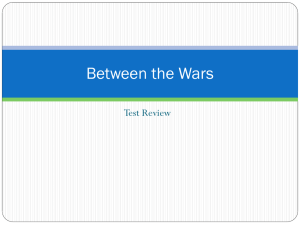World War I and Post War World Ch. 14.1-14.4
advertisement
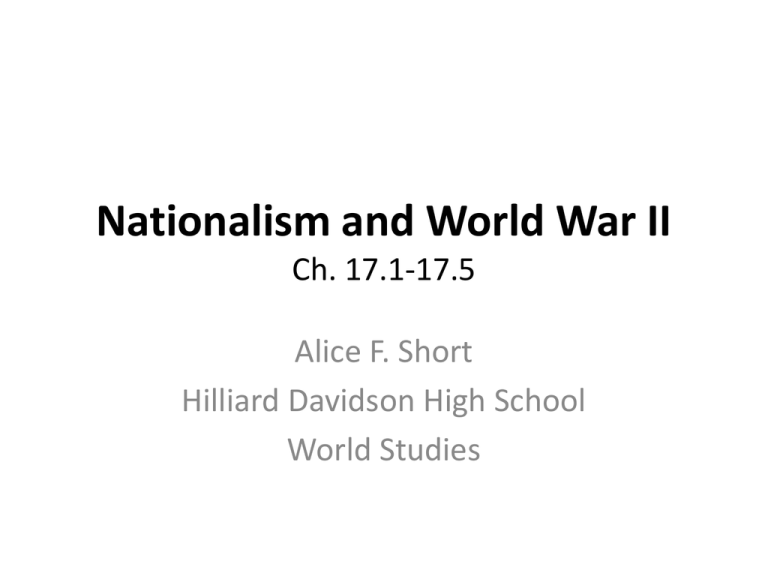
Nationalism and World War II Ch. 17.1-17.5 Alice F. Short Hilliard Davidson High School World Studies Nationalism and World War II Topic: Achievements and Crises (1900-1945) • The first half of the 20th century was one of rapid technological advances. It was a period when the tensions between industrialized nations resulted in World War I and set the stage for World War II. While World War II transformed the balance of world power, it was the most destructive and costly war in terms of human casualties and material resources expended. Content Statements: 15. The consequences of World War I and the worldwide depression set the stage for the Russian Revolution, the rise of totalitarianism, aggressive Axis expansion and the policy of appeasement which in turn led to World War II. 16. Oppression and discrimination resulted in the Armenian Genocide during World War I and the Holocaust, the state-sponsored mass murder of Jews and other groups, during World War II. 17. World War II devastated most of Europe and Asia, led to the occupation of Eastern Europe and Japan, and began the atomic age. Nationalism and World War II Topic: Historical Thinking and Skills • Students apply skills by utilizing a variety of resources to construct theses and support or refute contentions made by others. Alternative explanations of historical events are analyzed and questions of historical inevitability are explored. 1. Historical events provide opportunities to examine alternative courses of action. (Was World War II inevitable? Was their an alternative response to the Holocaust by Allied nations?) 2. The use of primary and secondary sources of information includes an examination of the credibility of each source. (Article 231, Hitler Youth literature) 3. Historians develop theses and use evidence to support or refute positions. (students assigned thesis and they must defend it) 4. Historians analyze cause, effect, sequence, and correlation in historical events, including multiple causation and long- and short-term causal relations. (WWI Appeasement; ineffective League of Nations Japan’s aggression) World War II Begins Chapter 17, Lesson 1 • The German Path to War – Hitler Violates Treaty • demilitarized • appeasement – – – – New Alliances Union with Austria Demands and Appeasement Hitler and the Soviets • The Japanese Path to War – War With China – The New Asian Order – Japan Launches Attack The German Path to War • The German Path to War – Hitler Violates Treaty • demilitarized • appeasement – New Alliances – Union with Austria – Demands and Appeasement – Hitler and the Soviets Hitler Violates Treaty • so-called Aryan race – believe superior to all other races and nationalities – Hitler wanted to dominate other (inferior) countries • Hitler Violates Treaty of Versailles – draft (100,000 550,000 troops) – demilitarized – elimination or prohibition of weapons, fortifications, and other military installations – appeasement – satisfying reasonable demands of dissatisfied powers in an effort to maintain peace and stability – Hitler was confident that the Western states that had signed the Treaty of Versailles would not mobilize their militaries to enforce it. Hitler and the Weimar Republic • Weimar Republic = unpopular gov’t est. in Germany following WWI – economic burden of reparations to Germany’s former enemies – allowed for rise of Nazi dictatorship – anger over the Treaty of Versailles let to increased nationalism and helped Hitler’s rise to power New Alliances • Germany and Italy – Benito Mussolini – Italian leader during WWII – Italy invades Ethiopia – both support Francisco Franco (leader of Nationalists that became Spanish dictator) • Rome-Berlin Axis (1936) – Hitler and Mussolini • Anti-Comintern Pact (1936) – Japan and Germany – against communisim • AXIS POWERS: Germany, Italy and Japan Demands and Appeasement • building up fortifications in the Rhineland • Anschluss (union) – Germany annexed Austria (1938) – Appeasement • annexed Sudetenland in northwestern Czechoslovakia (1938) • Munich Conference – height of appeasement – Neville Chamberlain = wuss and initial PM • British Prime Minister that appeased Hitler – Winston Churchill = said agreement was a hot mess • Great Britain’s Prime Minister during majority of WWII • took control of Moravia and Bohemia of western Czechoslovakia (1939) • Austria and Czechoslovakia = occupied w/o opposition from France and Great Britain • ENDING APPEASEMENT: Poland (France and Britain declare war on Germany) • “phony war” refers to the lack of combat early in WWII Hitler and the Soviets • Nazi-Soviet Non-Aggression Pact (1939) – Joseph Stalin – leader of the Soviet Union (USSR) – promised to not attack each other – always planned to break it – avoided additional front in war – Hitler will break when he invades the Soviet Union on June 22, 1941—earlier than Stalin anticipated The Japanese Path to War • The Japanese Path to War – War With China – The New Asian Order – Japan Launches Attack – Hideki Tojo - Japanese Prime Minister that led to Pearl Harbor attack on December 7, 1941 – Isoroku Yamamoto - Admiral that planned Pearl Harbor attack on December 7, 1941 War with China • Manchuria puppet government of Manchukuo – wanted natural resources for industries • League of Nations involvement – all bark and no bite • War with China – Rape of Nanjing – Chinese defeated continued to resist The New Asian Order • Greater East Asia Co-Prosperity Sphere – forced China to join a New Order in East Asia • Japan, Manchuria, China – created by Japan – exploited the resources of its colonies for its war machine – claimed it was to liberate parts of Southeast Asia from Western colonial rule – claimed guiding neighbors to prosperity Japan Launches Attack • Japanese expansion fulfilled need to control sources of raw materials for its industries – looks to South Asia for raw materials • US economic sanctions threatened Japan’s long-term goals – decision for Pearl Harbor surprise attack – Pearl Harbor attack led the United States to enter WWII World War II Chapter 17, Lesson 2 • Europe at War – Hitler’s Early Victories • blitzkrieg • isolationism • neutrality – The Battle of Britain – air battle between German and British air forces • Luftwaffe – name of the German air force – Attack on the Soviet Union • Japan at War • The Allies Advance – The European Theater – The Tide Turns – The Asian Theater Europe at War • Europe at War – Hitler’s Early Victories • blitzkrieg – “lightning war” • isolationism • neutrality – The Battle of Britain • Luftwaffe – name of the German air force – Attack on the Soviet Union Hitler’s Early Victories • Hitler’s Early Victories – blitzkrieg – isolationism – Neutrality • Maginot Line • Low countries of northwestern Europe (allowed Hitler to attack France above the Maginot Line after capturing them) – Netherlands – Belgium – Luxembourg • Dunkerque – French city – Hitler made a major mistake when he did not send ground troops to attack the allies here The Battle of Britain • The Battle of Britain – British air force rebuilt its strength The U.S. “is not involved” • Lend-Lease Act – allowed the U.S. to supply Great Britain with weapons and supplies before officially entering the war U.S. Initial Involvement • What’s already happened? – Appeasement – France had fallen to the Germans – the Battle of Britain had caused major damage to British cities – the British defeated Germany at El-Alamein • Northern Africa - western Allies focus their attention on battling the Axis Powers after the U.S. entered the war – angers USSR—WHY? Attack on the Soviet Union • Attack on the Soviet Union – Joseph Stalin – leader of USSR – fear that the Soviet Union would support Britain – Battle of Stalingrad – a crushing defeat for Germany because the entire Sixth Army lost • • • • considered to be the best German troops the turning point in Eastern Europe Soviets halted the German advance allowed Soviets to then push into Germany from the east – Soviet Union – experienced severe food and housing shortages because all resources went to the war economy Japan at War • Japan at War The Allies Advance • The Allies Advance – The European Theater – The Tide Turns • unity and purpose helps Allies – The Asian Theater • IMPORTANT ALLIED POWERS: Great Britain, France, United States, Soviet Union • FLYING SOLO: Switzerland The European Theater • The Allies Advance – The European Theater – The Tide Turns – The Asian Theater The Tide Turns • The Tide Turns The Asian Theater • Douglas MacAurthur – commander of the Allied forces in the Pacific • Guadalcanal – first piece of significant Japanesecontrolled territory taken by the Allies • island hopping – campaign carried out to get close enough to mainland Japan to take over – the use of airbases by the Allies on islands in the Pacific • Battle of Midway – turning point of the Pacific – U.S. won because they broke code and intercepted key Japanese messages • Iwo Jima – important because Japan used airfields on the island to support its naval forces 1. terrain made fighting very difficult 2. extreme bravery of U.S. Marines World War II • Europe at War – Hitler’s Early Victories • blitzkrieg • isolationism • neutrality – The Battle of Britain – Attack on the Soviet Union • Japan at War • The Allies Advance – The European Theater – The Tide Turns – The Asian Theater The Home Front and Civilians Chapter 17, Lesson 3 • The Mobilization of Four Nations • widespread • mobilization – – – – The Soviet Union The United States Germany Japan • kamikaze • The Bombing of Cities – Britain • blitz – Germany • circumstances – Japan The Mobilization of Four Nations • The Mobilization of Four Nations • widespread • mobilization – process of preparing troops and supplies for war – The Soviet Union – The United States • experience of war = different not fighting on own territory – Germany • during the first two years of the war, Hitler did not increase armaments production because he did not want to ruin citizen’s morale • use of forced labor disrupted industrial production in occupied territories that could have helped Germany • increased workforce by using citizens from conquered territories – Japan • kamikaze – suicide mission in which young Japanese pilots flew their planes into U.S. fighting ships at sea The Bombing of Cities • The Bombing of Cities – Britain • blitz – bombed civilian populations of enemies – British term for German air raids during World War II – to frighten civilians and weaken morale – believed it would force them to make peace – Germany • circumstances – Japan The New Order and the Holocaust Chapter 17, Lesson 4 • The New Order in Europe – ethnic • The Holocaust – The Einsatzgruppen – The Death Camps – The Death Toll • collaborator • The New Order in Asia The New Order in Europe • ethnic • Nuremberg Laws - as part of the Nuremberg Laws passed in 1935, the rights of German Jews were restricted and they were forced to wear the yellow Star of David on their clothes so they could be easily identified • Kristallnacht - November 10, 1938—the term for the nationwide attack on Jewish businesses and synagogues throughout Germany. 30,000 Jews were arrested and sent to prison camps • ghettos - in 1939, Jews from throughout Europe were forced from their homes and required to live in ghettos or confined areas within a city The Holocaust • The Holocaust – – – – victims included larger numbers of European Jews The Einsatzgruppen The Death Camps The Death Toll • collaborators – person who assists the enemy – The Final Solution – Nazi plan for the extermination of the Jews – Germany ruled some areas through direct annexation (Poland) – most territories run by local collaborators (including the Holocaust) Resistance to the Holocaust • bombing concentration camps – WHY? The New Order in Asia • The New Order in Asia World War II Ends Chapter 17, Lesson 5 • Tehran Conference – meeting of the Big Three to discuss the final attack on Germany • The Last Years of the War – The European Theater • partisan – resistance fighter in WWII – The Asian Theater • Peace and a New War – cold war – ideological – assure The Last Years of the War: European Theater • 1943: Mussolini was overthrown because Allies invaded Italy • “soft underbelly” – refers to invading through Italy • Normandy – sight of the D-Day invasion – “second front” – beaches at Normandy in France allowed Allies to attack Germany from the west at the same time as from the East • approached Germany from all sides – – – – liberated Paris crossed the Rhine met the Soviets at the Elbe River reoccupied the Ukraine, the Baltics and Warsaw and southern states (Soviet Union) • Adolf Hitler: commits suicide • partisan – resistance fighter in France – Charles de Gaulle – leader for the Free French Resistance • president of France after WWII • V-E Day – the day that the peace treaty was signed between Germany and the Allies, ending WWII in Europe The Pacific Theater • Bataan Death March – Japanese soldiers forced thousands of prisoners of war (POWs) to march many miles in harsh conditions – over 10,000 U.S. and Filipino soldiers died • Philippines - in October 1944, the Allies invaded here, but didn’t control it until April 1945. This was the largest battle in the Pacific, and also the first battle where Japanese used kamikaze tactics • Battle of Iwo Jima 1. 2. terrain made fighting very difficult extreme bravery of U.S. Marines • Okinawa – “Typhoon of Steel” – last defensive position of Japan • Harry S. Truman – decision to drop the bomb – thought that a land invasion of Japan would kill too many U.S. troops – the ferocity of Japanese resistance increased as soldiers refused to surrender (kamikaze attacks, training kids to fight, etc.) – atomic bombings of Hiroshima (1st) and Nagasaki (2nd) ended war in the Pacific Peace and a New War • Yalta, February 1945 – Big Three • Potsdam Conference, July 1945 – Truman replaces Roosevelt – Truman demanded free elections throughout Eastern Europe – Soviets didn’t want elections (wanted to keep control) • Peace and a New War – cold war – period of political tension between the United States and the Soviet Union • Winston Churchill compared postwar Soviet policy in Eastern Europe to an iron curtain – ideological – assure Legacy of WWII • approximately 50 million people were killed – can be debated – Soviet Union suffered the most casualties • BOTH military and civilian neg. impact on relations
